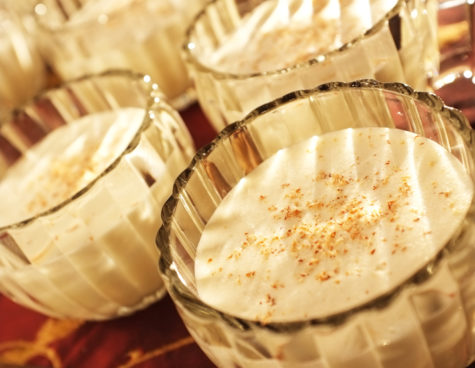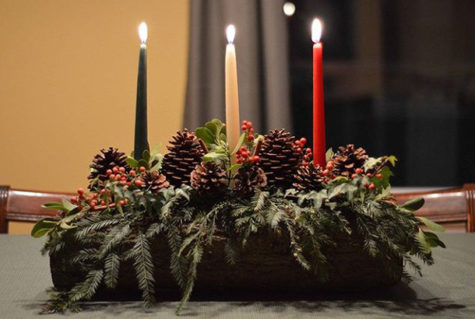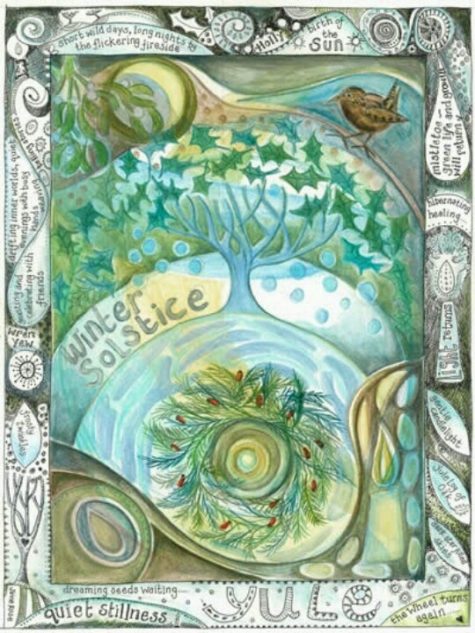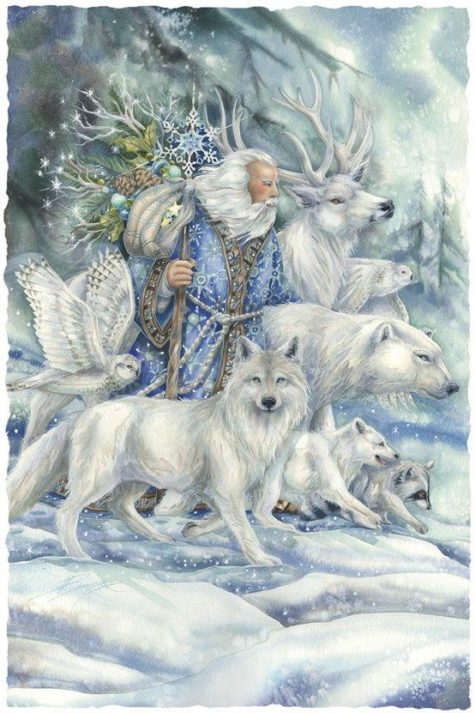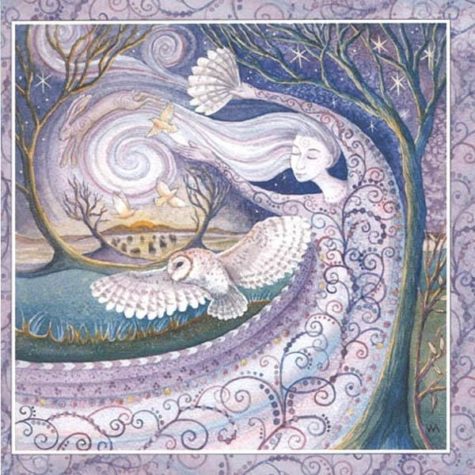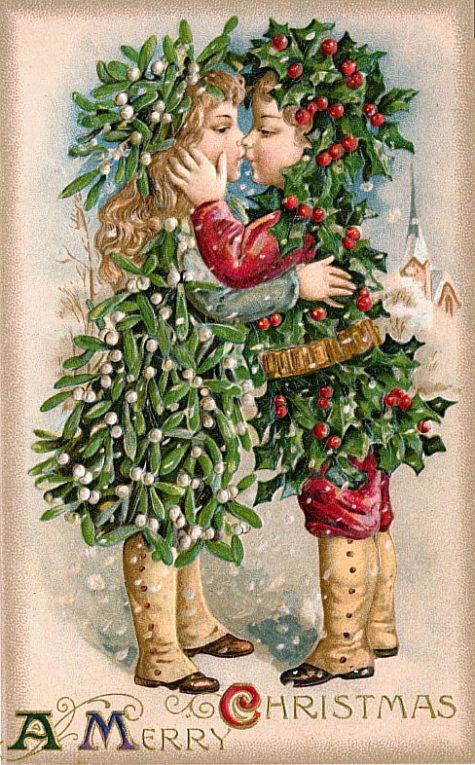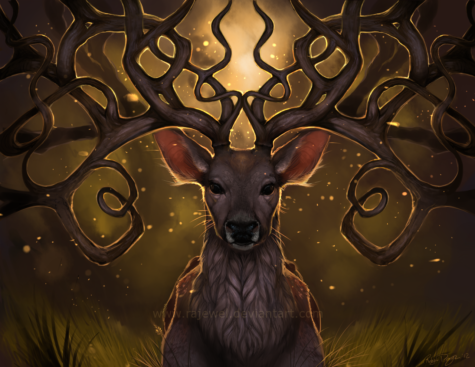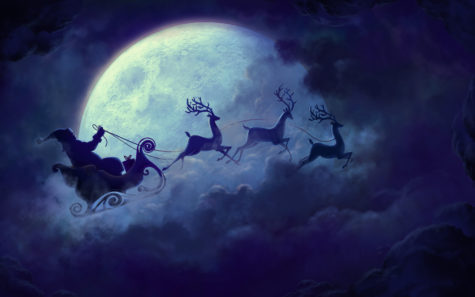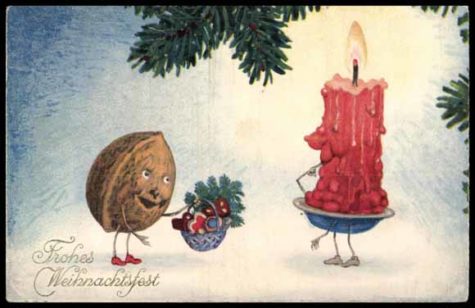Yule
While culinary historians debate its exact lineage, most agree eggnog originated from the early medieval Britain “posset,” a hot, milky, ale-like drink. By the 13th century, monks were known to drink a posset with eggs and figs. Milk, eggs, and sherry were foods of the wealthy, so eggnog was often used in toasts to prosperity and good health.
Eggnog became tied to the holidays when the drink hopped the pond in the 1700s. American colonies were full of farms—and chickens and cows—and cheaper rum, a soon-signature ingredient. Mexico adopted the very eggnog varietal “rompope,” and Puerto Rico enjoys the “coquito,” which adds coconut milk. The English name’s etymology however remains a mystery. Some say “nog” comes from “noggin,” meaning a wooden cup, or “grog,” a strong beer. By the late 18th century, the combined term “eggnog” stuck.
Eggnog purists argue that those who don’t like the Yuletide drink have simply never tasted the real thing. Sugar-laced supermarket versions can’t hold a candle to the homemade goodness, especially since the US Food and Drug Administration permits that the drink can be made from as little as 1% egg yolk. That often borders on “milknog” or egg flavoring.
Our founders would have had none of that. George Washington even penned his own famous heavy-on-the-alcohol eggnog recipe. Only one problem: he forgot to record the exact number of eggs. Cooks in his era estimated a dozen would do:
One quart cream, one quart milk, one dozen tablespoons sugar, one pint brandy, 1/2 pint rye whiskey, 1/2 pint Jamaica rum, 1/4 pint sherry—mix liquor first, then separate yolks and whites of eggs, add sugar to beaten yolks, mix well. Add milk and cream, slowly beating. Beat whites of eggs until stiff and fold slowly into mixture. Let set in cool place for several days. Taste frequently.
Here’s another recipe:
Ingredients:
- 12 eggs
- 1 1/2 cups sugar
- 1/4 tsp salt
- 1 qt heavy cream
- 1 qt milk
- 1 qt bourbon whiskey
- 1 cup rum
- nutmeg
Separate the eggs. Beat the egg whites together until stiff, then beat in a 1/2 cup of sugar. Beat the egg yolks until pale and light. Add the remaining cup of sugar and a 1/4 tsp of salt.
Combine the egg mixture with the milk and the bourbon. Beat well, then add the cup of rum. Pour into a jug and store in a cool place. Shake or stir thoroughly before serving. Ladle into small cups and sprinkle with nutmeg. Serves 30.
Note:
Make this about a week before serving to allow it to mellow. Scotch whiskey or rum may be substituted for the bourbon.
Death By Eggnog
And as you enjoy your holiday cheer, please drink responsibly. As you can see in the following report about Death By Eggnog, too much of a good thing can be … well… deadly!
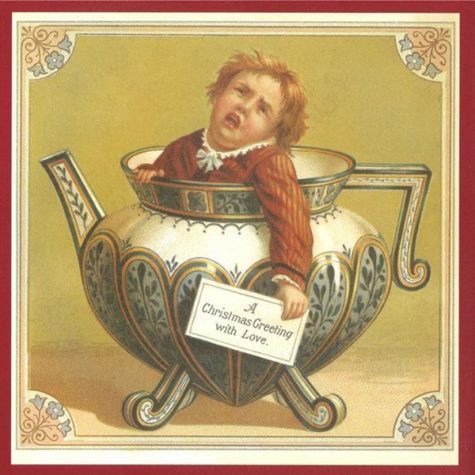
The testimony and investigation into the death of Addison Williams, dated 18 January 1873, can be found in the Bedford County Coroners’ Inquisitions, 1813-1899. The collection is open for research and available at the Library of Virginia.
On 25 December 1872 in Bedford County, VA, Williams paid a visit to the home of Cornelia and Charles Abram. He arrived “about light” and was given a dram of whiskey by William Ogden. Ogden then made a gallon of eggnog, and Williams “drank a glass and repeated several times.” Everyone present “drank eggnog freely,” but Williams enjoyed it most of all, drinking more than the rest of the party.
He “left the house and threw up,” only to come back and take another drink. Afterwards, Williams “left in a run, as in a prank,” never to be seen again. Williams “had commenced showing he was under the influence of liquor,” but no one at the party thought him too drunk to make it home. As one party goer put it, “…as I thought he was going so well it was useless for me to go with him.”
Unfortunately, Williams could have used a little assistance. He was found on Christmas morning “dead and frozen” mere yards from his house. The resulting coroner’s inquisition determined Williams came to his death as a result of “being exposed to the cold after drinking a large quantity of mean whiskey.”
Sources:
For the Wassail’s Baked Apples:
- 1 dozen cooking apples
- 1 cup brown sugar
- 3 tablespoons cinnamon
- butter or margarine
- 3/4 cup boiling water
- 2 tablespoons sugar
Core apples and place in an 8 X 8 inch baking pan. Mix sugar and cinnamon, fill apples with mixture, dot tops with butter. Add boiling water and sugar to pan and bake at 375 degrees Fahrenheit for 40 to 60 minutes.
For the Wassail:
- 1 cup water
- 4 cups sugar
- 1 tablespoon nutmeg, grated (for luck)
- 1/2 teaspoon mace
- 2 teaspoons ginger (to prevent arguments)
- 6 whole cloves (to influence people in high places, and for luck)
- 1 stick cinnamon (same as cloves)
- 6 whole allspice
- 1 dozen eggs, separated
- 4 bottles sherry
- 2 cups brandy
Combine first eight ingredients in a saucepan and boil for 5 minutes. Beat egg whites until stiff. In a separate bowl, beat egg yolks. Fold whites into yolks. Strain spice mixture into egg mixture and stir. Combine sherry and brandy and bring almost to a boil. Gradually add liquor to spice and egg mixture, stirring rapidly as you do so.
Before serving, add baked apples to foaming liquid. Serve in a large cauldron.
- One practice consists of lighting and burning a Yule Log.
If you choose to burn one, select a proper log of oak or pine. Carve (with your Bolline) or chalk upon it a figure of the Sun (a rayed disc) or the Horned God (a horned circle). Set it alight in the fireplace at dusk, on Yule. This is a graphic representation of the rebirth of the God within the sacred fire of the Mother Goddess.
As the log burns, visualize the Sun shining within it and think of the coming warmer days. Traditionally, a portion of the Yule Log is saved to be used in lighting next year’s log. This piece is kept throughout the year to protect the home.
- The second type of Yule Log is not burned up, but rather holds three candles for burning.
Find a suitable log of oak or pine and flatten one side of it so that it will lay flat. Drill three holes in the side that is up, the correct size for holding three taper candles. The candles should be red, green and white (to represent the season), or green, gold and black (to represent the Sun God), or white, red and black (to represent the Great Goddess).
You can further decorate your Yule Log however you choose to – using holly, mistletoe, red ribbons and bows, or whatever you prefer.
Source: Citadel of the Dragons
Winter Solstice has been celebrated in cultures the world over for thousands of years. This start of the solar year is a celebration of Light and the rebirth of the Sun. In old Europe, it was known as Yule, from the Norse, Jul, meaning wheel.
Today, many people in Western-based cultures refer to this holiday as “Christmas.” Yet a look into its origins of Christmas reveals its Pagan roots.
Emperor Aurelian established December 25 as the birthday of the “Invincible Sun” in the third century as part of the Roman Winter Solstice celebrations. Shortly thereafter, in 273, the Christian church selected this day to represent the birthday of Jesus, and by 336, this Roman solar feast day was Christianized. January 6, celebrated as Epiphany in Christendom and linked with the visit of the Magi, was originally an Egyptian date for the Winter Solstice.
Most of the customs, lore, symbols, and rituals associated with “Christmas” actually are linked to Winter Solstice celebrations of ancient Pagan cultures. While Christian mythology is interwoven with contemporary observances of this holiday time, its Pagan nature is still strong and apparent.
Pagans today can readily re-Paganize Christmastime and the secular New Year by giving a Pagan spiritual focus to existing holiday customs and by creating new traditions that draw on ancient ways. Here are some ways to do this: Celebrate Yule with a series of rituals, feasts, and other activities.
In most ancient cultures, the celebration lasted more than a day. The ancient Roman Saturnalia festival sometimes went on for a week. Have Winter Solstice Eve and Day be the central focus for your household, and conceptualize other holiday festivities, including New Year’s office parties and Christmas visits with Christian relatives, as part of your Solstice celebration. By adopting this perspective, Pagan parents can help their children develop an understanding of the multicultural and interfaith aspects of this holiday time and view “Christmas” as just another form of Solstice.
Have gift exchanges and feasts over the course of several days and nights as was done of old. Party hearty on New Year’s Eve not just to welcome in the new calendar year, but also to welcome the new solar year.
Adorn the home with sacred herbs and colors. Decorate your home in Druidic holiday colors red, green, and white. Place holly, ivy, evergreen boughs, and pine cones around your home, especially in areas where socializing takes place.
Hang a sprig of mistletoe above a major threshold and leave it there until next Yule as a charm for good luck throughout the year. Have family/household members join together to make or purchase an evergreen wreath. Include holiday herbs in it and then place it on your front door to symbolize the continuity of life and the wheel of the year. If you choose to have a living or a harvested evergreen tree as part of your holiday decorations, call it a Solstice tree and decorate it with Pagan symbols.
Convey love to family, friends, and associates. At the heart of Saturnalia was the custom of family and friends feasting together and exchanging presents. Continue this custom by visiting, entertaining, giving gifts, and sending greetings by mail and/or phone. Consider those who are and/or have been important in your life and share appreciation.
Reclaim Santa Claus as a Pagan Godform. Today’s Santa is a folk figure with multicultural roots. He embodies characteristics of:
- Saturn (Roman agricultural god)
- Cronos (Greek god, also known as Father Time)
- Holly King (Celtic god of the dying year)
- Father Ice/Grandfather Frost (Russian winter god)
- Thor (Norse sky god who rides the sky in a chariot drawn by goats)
- Odin/Wotan (Scandinavian/Teutonic All-Father who rides the sky on an eight-legged horse)
- Frey (Norse fertility god)
- Tomte (a Norse Land Spirit known for giving gifts to children at this time of year)
Santa’s reindeer can be viewed as forms of Herne, the Celtic Horned God. Decorate your home with Santa images that reflect His Pagan heritage.
Honor the Goddess as Great Mother. Place Pagan Mother Goddess images around your home. You may also want to include one with a Sun child, such as Isis with Horus. Pagan Goddess forms traditionally linked with this time of year include:
- Tonantzin (Native Mexican corn mother)
- Holda (Teutonic earth goddess of good fortune)
- Bona Dea (Roman women’s goddess of abundance and prophecy)
- Ops (Roman goddess of plenty)
- Au Set/Isis (Egyptian/multicultural All Goddess whose worship continued in Christian times under the name Mary)
- Lucina/St. Lucy (Roman/Swedish goddess/saint of light)
- Befana (Italian Witch who gives gifts to children at this season)
Honor the new solar year with light. Do a Solstice Eve ritual in which you meditate in darkness and then welcome the birth of the sun by lighting candles and singing chants and Pagan carols.
If you have a indoor fireplace or an outdoor fire circle, burn an oak log as a Yule log and save a bit to start next year’s fire. Decorate the inside and/or outside of your home with electric colored lights. Because of the popularity of five pointed stars as holiday symbols, this is a good time to display a pentagram of blue or white lights.
Contribute to the manifestation of more wellness on Planet Earth. Donate food and clothing to poor in your area. Volunteer time at a social service agency. Put up bird feeders and keep them filled throughout the winter to supplement the diets of wild birds. Donate funds and items to non-profit groups, such as Pagan/Wiccan churches and environmental organizations. Meditate for world peace. Work magic for a healthier planet. Make a pledge to do some form of good works in the new solar year.
by Selena Fox
When all is done, when the twelve days of Christmas are over, we may begin to look forward to the next year. It is time to dismantle your Solstice shrine (if you made one) and time to take down the Christmas tree if you have one. Some things you will want to keep; the more ephemeral components can be returned to nature, to be remade next year.
As you put things away in a box for another year, give thanks to every single one of the gifts of the Solstice.
Here’s an a poem from an old French Epiphany carol:
Noel is leaving us, Sad to say,
But he will come again, Adieu Noel.
His wife and his children Weep as they go;
On a grey horse They ride through the snow.
The Kings ride away In the snow and the rain;
But after 12 months We shall see them again.
The Winter Solstice or Yule is one of the Lesser Wiccan Sabbats, and it is also the shortest day of the year, and hence – the longest night. This usually takes place on December 20th or 21st, although it does sometimes occur on the 22nd or 23rd (check your calendar as it changes from year to year).
Other than the most common name of Yule, various other names for the Winter Solstice include:
- Midwinter
- Yuletide (the Teutonic version)
- Alban Arthan (Caledonii Tradition, or the Druids)
- Feill Fionnain (Pecti-Wita Tradition, which falls on December 22nd).
Yuletide lasts from December 20th through December 31st. It begins on “Mother Night” and ends twelve days later, on “Yule Night”, hence the “Twelve Days of Christmas” tradition. Alban Arthan, unlike all the others, is not considered a fire festival.
Some other names for this Sabbat that are used less commonly are: Sun Return, Pagan New Year, Saturnalia (Roman), Great Day of the Cauldron, and Festival of Sol.
Yule is a time of the Goddess of the Cold Darkness and the birth of the Divine Child, the reborn Sun God. It is a time of renewal and rebirth during Winter, and the turning of the Earth force tides. A time when the waxing Sun overcomes the waning Sun. In some traditions, this is symbolized by the struggle between the Oak King and the Holly King.
The Holly King, represents the Death aspect of the God at this time of year; and the Oak King, represents the opposite aspect of Rebirth (these roles are reversed at Midsummer). This can be likened to the Divine Child’s birth. The myth of the Holly King/Oak King probably originated from the Druids to whom these two trees were highly sacred. The Oak King (God of the Waxing Year) kills the Holly King (God of the Waning Year) at Yule (the Winter Solstice). The Oak King then reigns supreme until Litha (the Summer Solstice) when the two battle again, this time with the Holly King victorious.
Examples of the Holly King’s image can be seen in our modern Santa Claus. He dons a sprig of holly in his hat, wears red clothing, and drives a team of eight (total number of Solar Sabbats) reindeer, an animal sacred to the Celtic Gods (deer). Mistletoe and holly came into modern Christmas celebrations through the memorializing of this battle. The holly with berries are hung in honor of the Holly King and mistletoe in honor of the Oak King. Although the Holly King and Oak King are mortal enemies at the two Solstices – Yule and Litha – it should be remembered that they are actually two sides of one whole, and neither would exist without the other.
Since this is a Solar Festival, it is celebrated by fire and the use of many candles orthe Yule Log. The colors of the season – red and green – are of original Pagan descent. Symbols representing Yule include an eight-spoked wheel symbol, evergreens, wreaths, holly, mistletoe, Yule Trees (very similar to the familiar “Christmas Trees”), or a small potted tree, and Yule Logs.
The act of decorating the Yule Tree, wreaths of holly, and the exchange of gifts are also Pagan derivatives. The Yule Tree can be a living, potted tree which can later be planted in the ground, a cut one, or even an artificial one. The choice is yours.
Appropriate Wiccan decorations range from strings of dried rosebuds, cinnamon sticks, popcorn or cranberries for garlands to bags of fragrant spices hung from boughs. Quartz crystals can be wrapped with shiny wire and suspended from sturdy branches to resemble icicles. Apples, oranges, lemons, nuts of all kinds and cookies hanging from boughs and branches are strikingly beautiful; and can be real or artificial, depending on your taste. These natural decorations were customary in ancient times. The reindeer stag is also a reminder of the Horned God. You will find that many traditional Christmas decorations have some type of Pagan ancestry or significance that can be added to your Yule holiday.
Deities to honor at this time of year include all Newborn Gods and Sun Gods, and all Mother Goddesses and Triple Goddesses. Appropriate Yule Gods include Apollo (Greek), Ra, Osiris, Horus, (all three are Egyptian), Lugh (Irish-Celtic), Odin (Norse), Father Sun (Native American), and Jesus (Christian-Gnostic), to name a few. Goddesses might include the Morrigan, Brigit (both Celtic), Isis (Egyptian), Demeter, Gaea, Pandora, Selene, and Artemis (all five are Greek), Juno and Diana (both Roman), Astarte (Middle Eastern), Spinning Woman (Native American) and the Virgin Mary (Christian-Gnostic).
Ritually, you may want to light fires within the Circle (in the cauldron, for instance), light candles and carry them around the Circle or bring the Yule log into the Circle and include it in your ceremony. Bayberry candles can be burned to ensure prosperity, growth and happiness throughout the following year. These can be inscribed with runes for health and money, or whatever is desired before lighting. They shall be lit at sunset and allowed to burn until they go out by themselves. An old Germanic poem says “A bayberry candle burned to the socket brings food to the larder and gold to the pocket.”
Spellwork for balance, beauty, peace, and harmony are great to perform at this time of the Pagan year. Love spells and spells to increase happiness are also appropriate. Key actions to remember for Yule are introspection and meditation.
The most common colors used at this Sabbat are red and green, but gold and white are also quite appropriate. Stones to be used at this celebration include bloodstones, rubies, and garnets. Animals associated with the Yule Sabbat are stags, squirrels, wrens and robins. Mythical creatures associated with Yule are the Phoenix, and trolls. Herbs and plants that can be used include holly, mistletoe, evergreens, poinsettias, bay, pine, ginger, valerian, and myrrh.
The foods of Yule include nuts, fruits such as apples and pears, cookies and cakes of caraway soaked in cider, and (for non-vegetarians) pork are all traditional fare. Fine drinks for the Yule celebration or meals include Wassail (a hot drink made from wine, beer or cider, spices, sugar, and usually baked apples—served in a large bowl), lamb’s wool (ale mixed with sugar, nutmeg and the pulp of roasted apples), hibiscus or ginger tea, and apple cider.
Source: Citadel of The Dragons
In certain areas of England there was an expression that if a dark moon came on Christmas, a fine harvest year would follow. Other areas declared that a waxing or new moon on Christmas portended a good year, but a waning moon a hard year.
From: Moon Magick
The sending of cards is a fairly modern tradition, and used to be only for people that you would not be actually seeing. It was considered polite to give your greetings in person, whenever you could. However, today clever marketing from the manufacturers means that we tend to send cards to everyone, even when they live in the same house.
Whether you celebrate Yule, Christmas or another festival in December, you will probably be sending greeting cards. If you do this now then not only do you save a panic later, but also you will have the time to do a bit more than just scrawl your name. For those people with whom you are not in regular contact, try writing a few lines telling them what’s happening in your world at present. You could also enclose a small token, perhaps a pressed flower, to bring them cheer. Of course if you have the time it can be nice to make your own cards, and there are kits which can be bought to help with this.
For special people make your card into a spell for them. Decorate it with flowers or other plants which will bring them good fortune, like Fern, Oak, Holly, Poppy, Rose petals, or Violet. Alternatively, select plants for harmony, like Lavender, Passion Flower and Gardenia.
So get out your address book, dust off your memory and write your cards, now, before the festive season gets fully under way. You’ll thank yourself for it later! And don’t forget to have a few cards over, just in case there’s someone you forget.
From: The Real Witches’ Year
Wassailing means “to wish health to” one’s apple trees, in the hope that they will bear well. In addition, drums, bells, whistles etc. were used either to scare off evil spirits, or to wake the tree up; a libation of cider or ale was poured over the roots, and bread that had soaked in the ‘wassailing’ bowl was placed in the branches – an offering back to the tree.
Note:
Recipes for wassail are numerous and varied. Some call for the use of apple cider, some for wine. The basic idea is that you are making a hot spiced drink and serving it in a bowl amidst love and laughter. Here is a simple recipe that calls for cranberry and orange juice. Feel free to experiment and substitute.
Ingredients:
- 4 cups cranberry juice
- 1/2 cup grenadine
- 2 cups orange juice
- 1/2 cup rum (optional)
- Sugar or honey – to taste
Directions:
Put everything into a large soup or stock pot and bring to a low simmer. If you added honey or sugar, mix gently until it dissolves. Lower the heat and very low simmer the mixture for 2 hours before serving. Keep it on low or use a crockpot on low if serving over hours. The longer you heat, the more infused the flavors will be.
Orange slices or orange wedges studded with cloves, cinnamon sticks, and cranberries can be floated in the pot and simmered along with the rest of the ingredients.
When you are ready to serve your Christmas Wassail, just ladle into your favorite mug and enjoy. This delicious and warm drink is a holiday treat! Garnish with a cinnamon stick if you like.
Source: Earthwitchery
Figgy pudding is a pudding resembling something like a white Christmas pudding containing figs. The pudding may be baked, steamed in the oven, boiled or fried. The history of figgy pudding dates back to 16th century England. Its possible ancestors include savory puddings such as crustades, fygeye or figge (a potage of mashed figs thickened with bread), creme boiled (a kind of stirred custard), and sippets. In any case, its methods and ingredients appear in diverse older recipes.
Today, the term figgy pudding is popularized mainly by the Christmas carol “We Wish You A Merry Christmas,” which includes the line, “Now bring us some figgy pudding” in the chorus.
And here it is (from Food.com) a recipe for Figgy Pudding. This is not a traditional pudding, it’s actually more bread or cake-like. The taste may be a little strange to some, but it smells and tastes like Christmas. The figgy pudding should always be served warm. If you can’t serve it fresh out of the oven, it will taste just fine to warm it in the microwave for a few seconds.
Ingredients:
- 16 ounces dried figs
- 1 3/4 cups milk
- 1 1/2 cups all-purpose flour
- 1 cup sugar
- 2 1/2 teaspoons baking powder
- 1 teaspoon ground nutmeg
- 1 teaspoon ground cinnamon
- 1 teaspoon salt
- 3 eggs
- 1/2 cup melted butter
- 1 1/2 cups breadcrumbs
- 1 tablespoon grated orange peel
Directions:
Preheat oven to 350 degrees F. In a a medium saucepan, heat milk and chopped figs over medium-low heat but do NOT bring to a boil. Cook for 10-15 minutes stirring occasionally. The the milk will soften the figs.
In a medium bowl mix flour, sugar, baking powder, nutmeg, cinnamon, and salt. In a large bowl, beat eggs one minute on high. Reduce speed to low and add butter, bread crumbs, orange peel, and warm fig mixture. Slowly incorporate flour mixture. Beat until just blended.
Pour the mix into the greased bundt pan. Level top as much as possible. Cover the mold with a piece of aluminum foil greased on one side, greased side down. Place the mold in a roasting pan and place on oven rack. fill with hot tap water 2 inches up the side of the mold. Bake for 2 hours or until the pudding is firm and it is pulling away from the side of the bundt pan.
Remove the pudding from the water bath. Remove the foil and cool on a wire rack for 10 minutes before unmolding. Invert bundt pan onto a serving plate and remove mold. It should come away easily.
Serve with a hard sauce.
